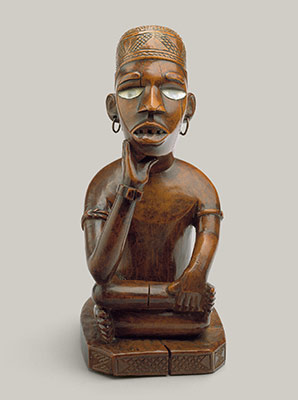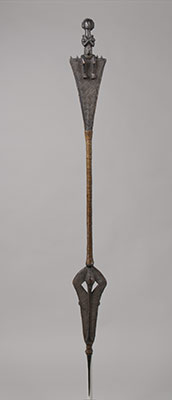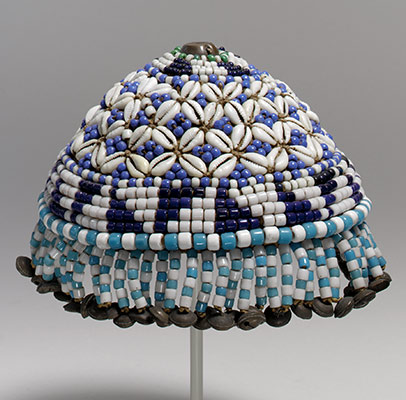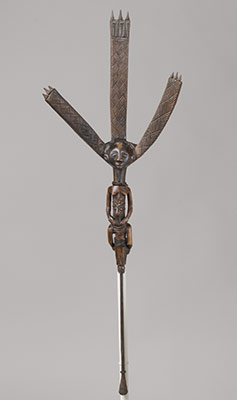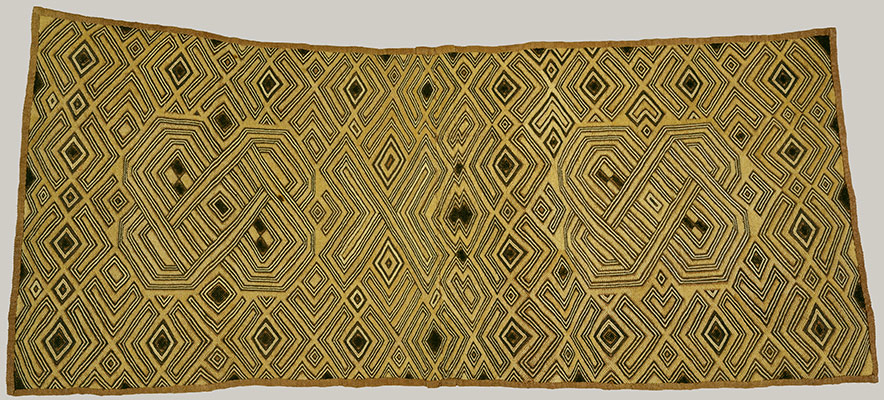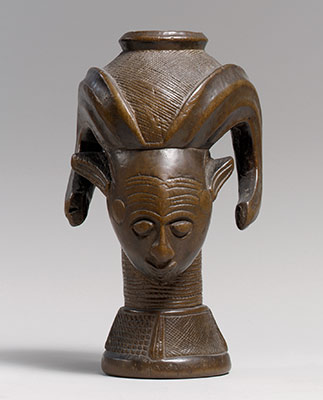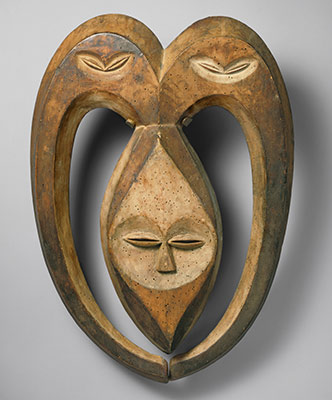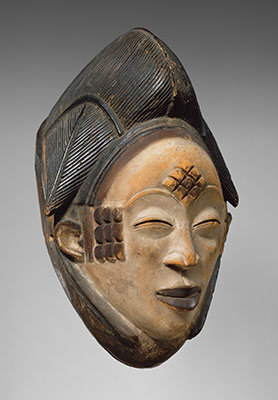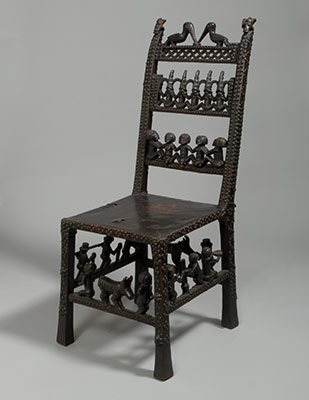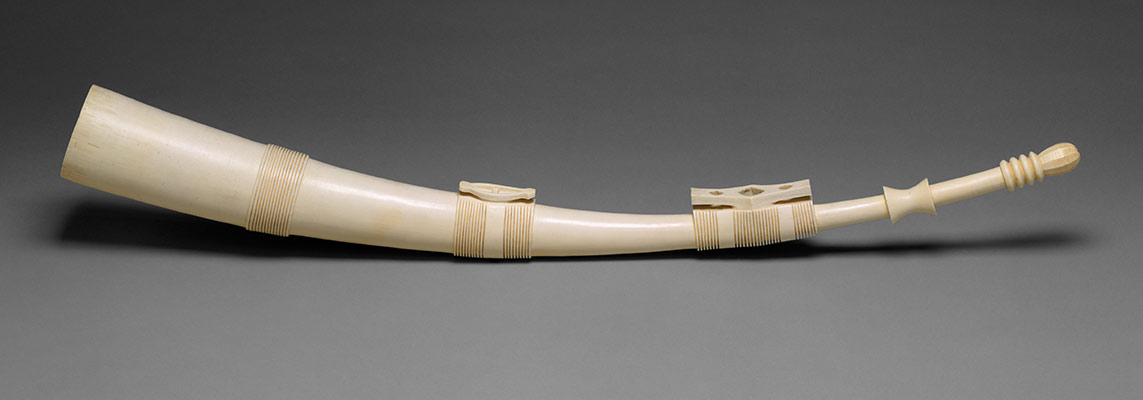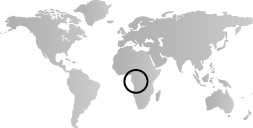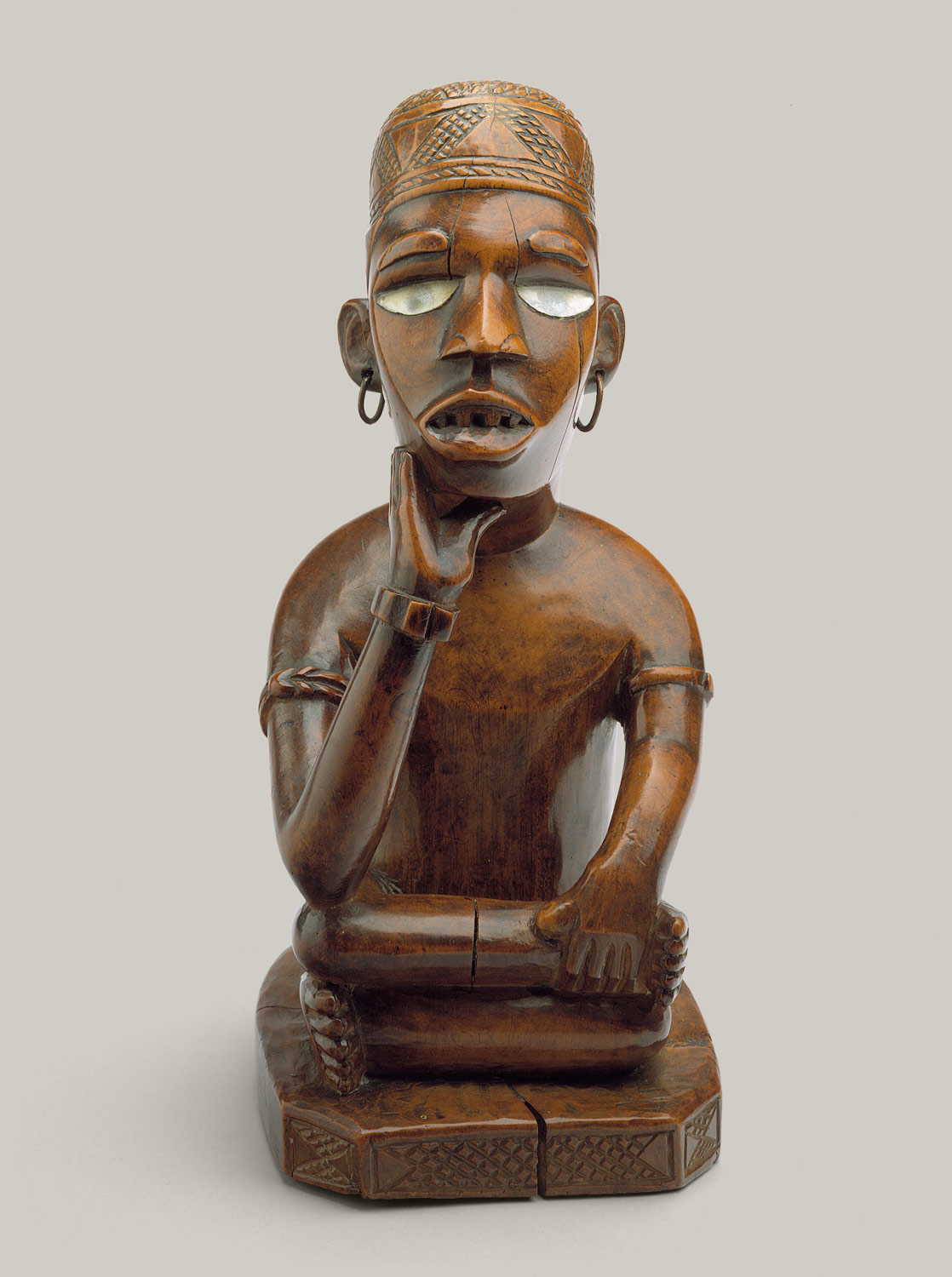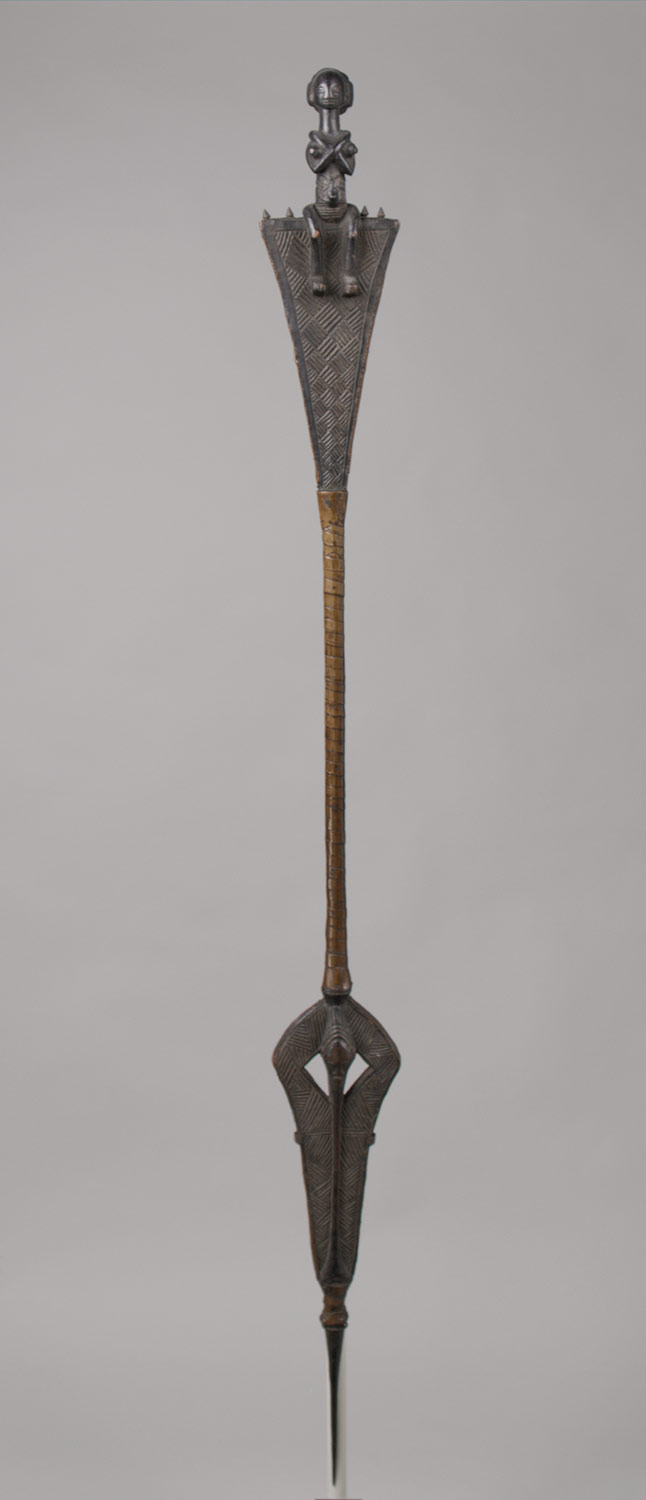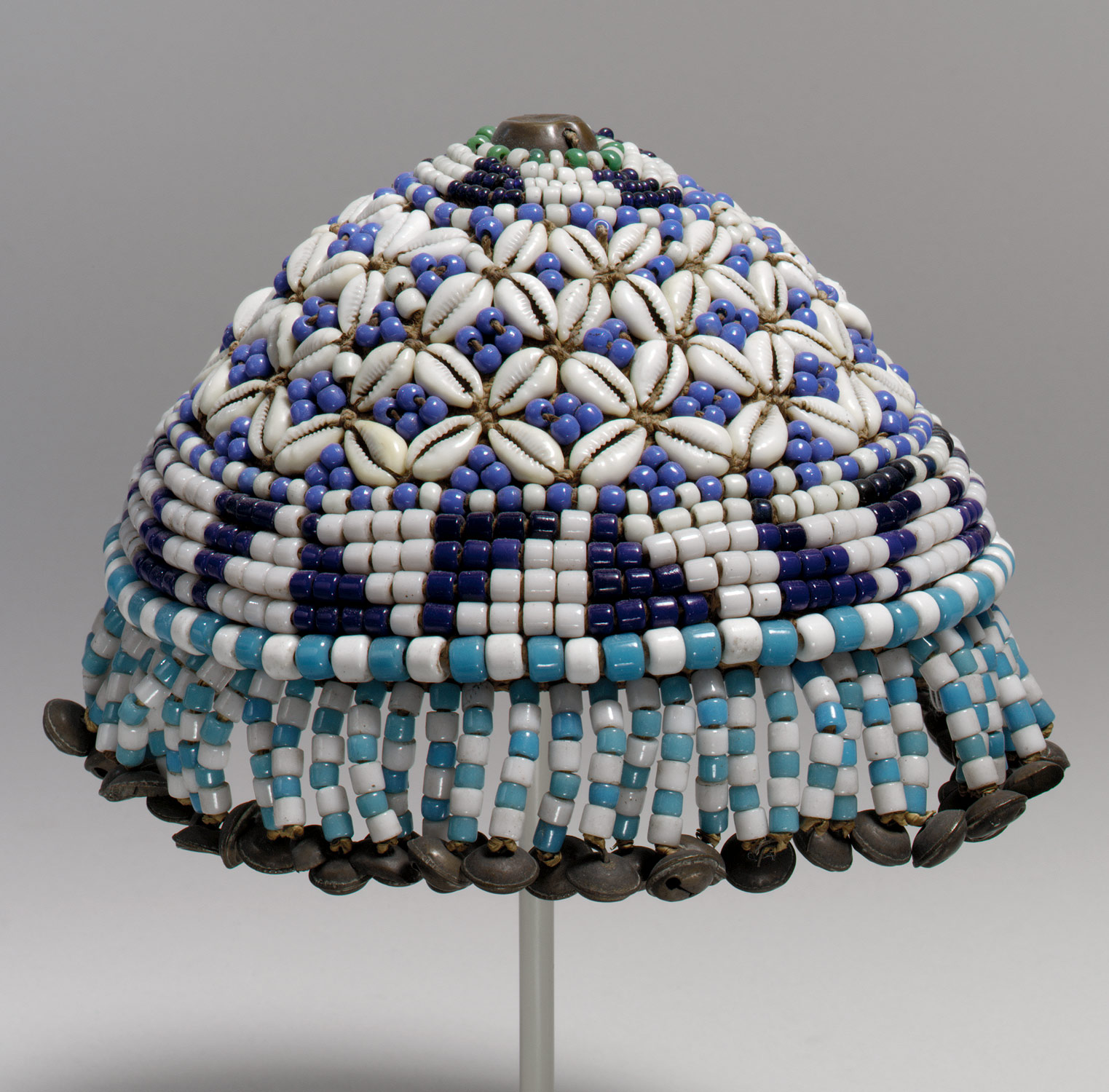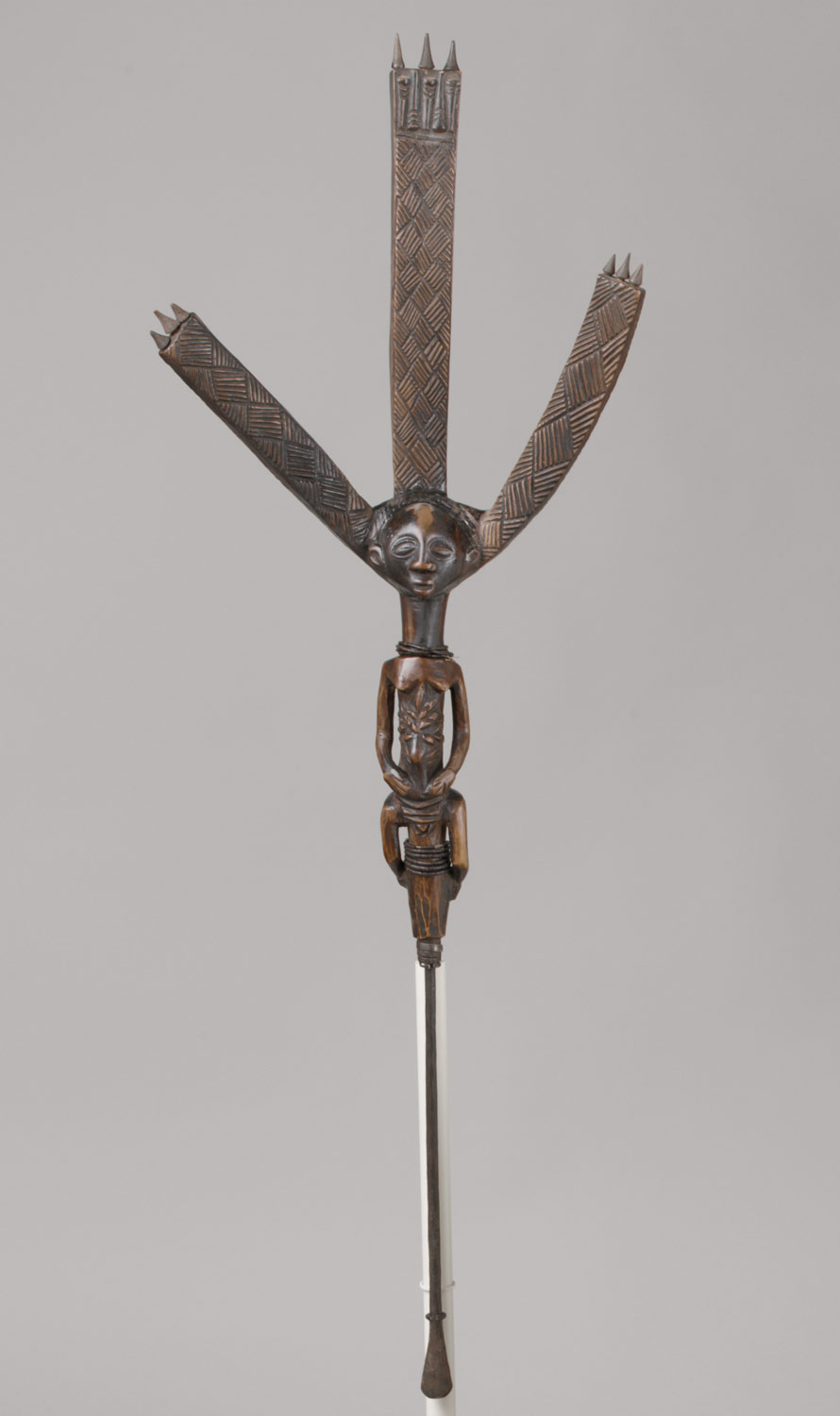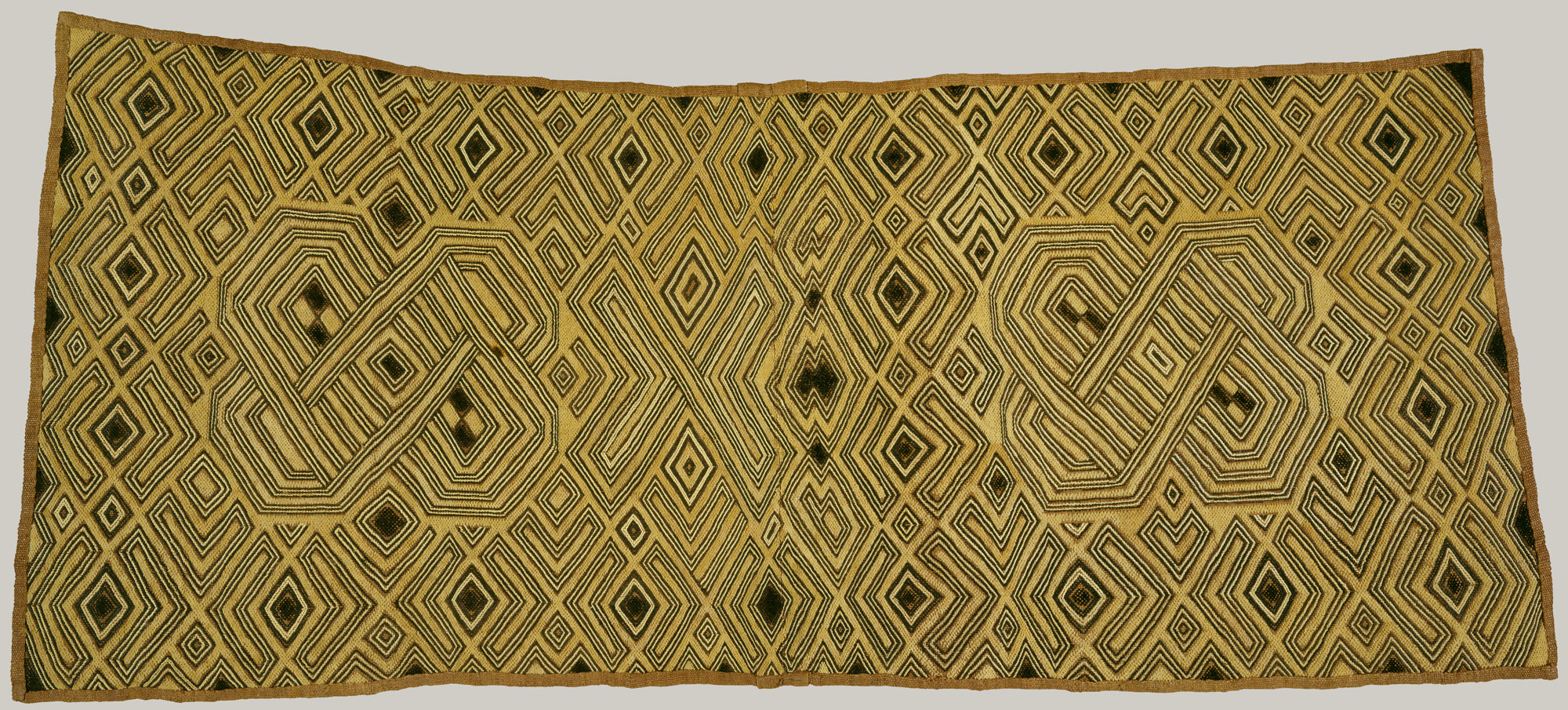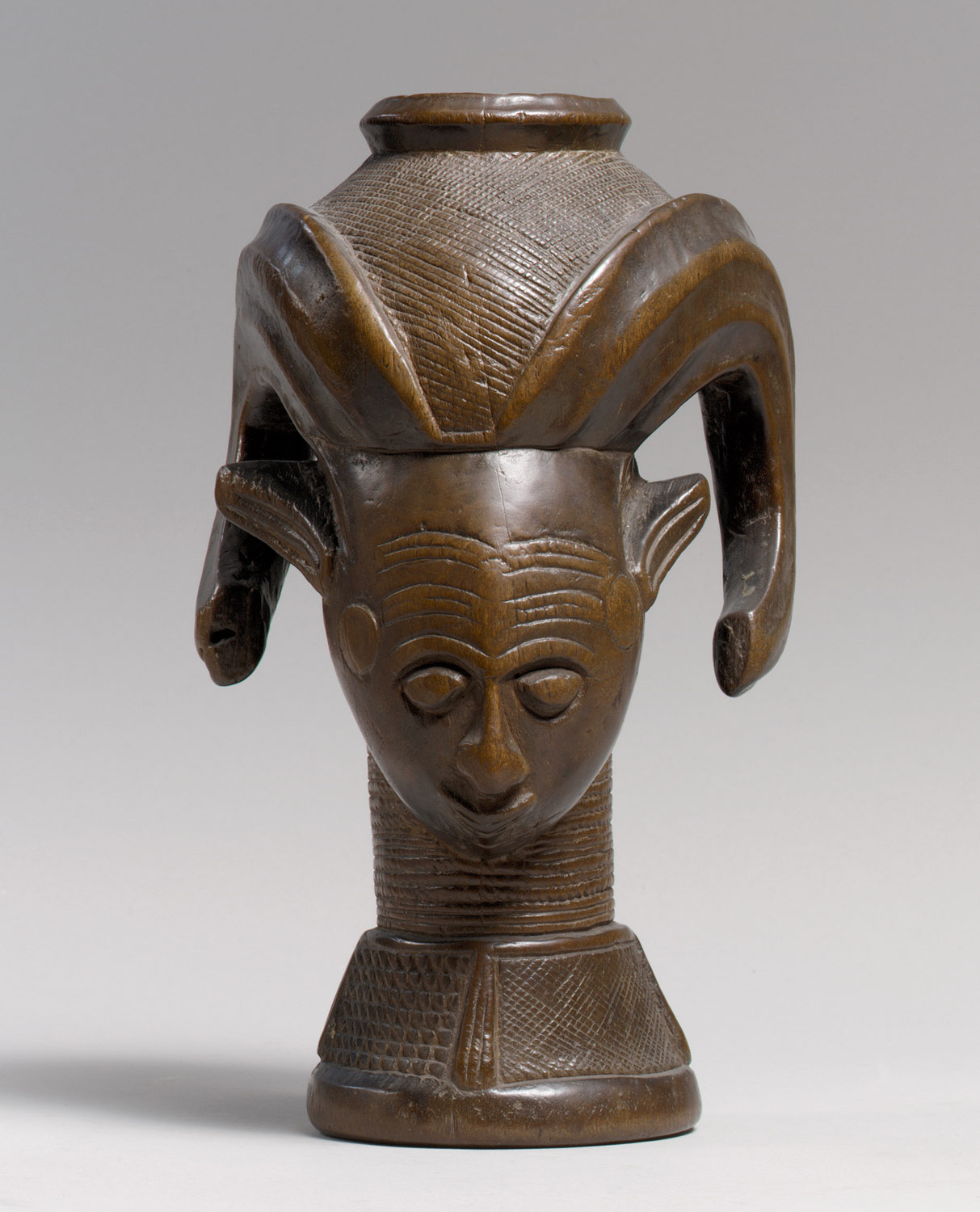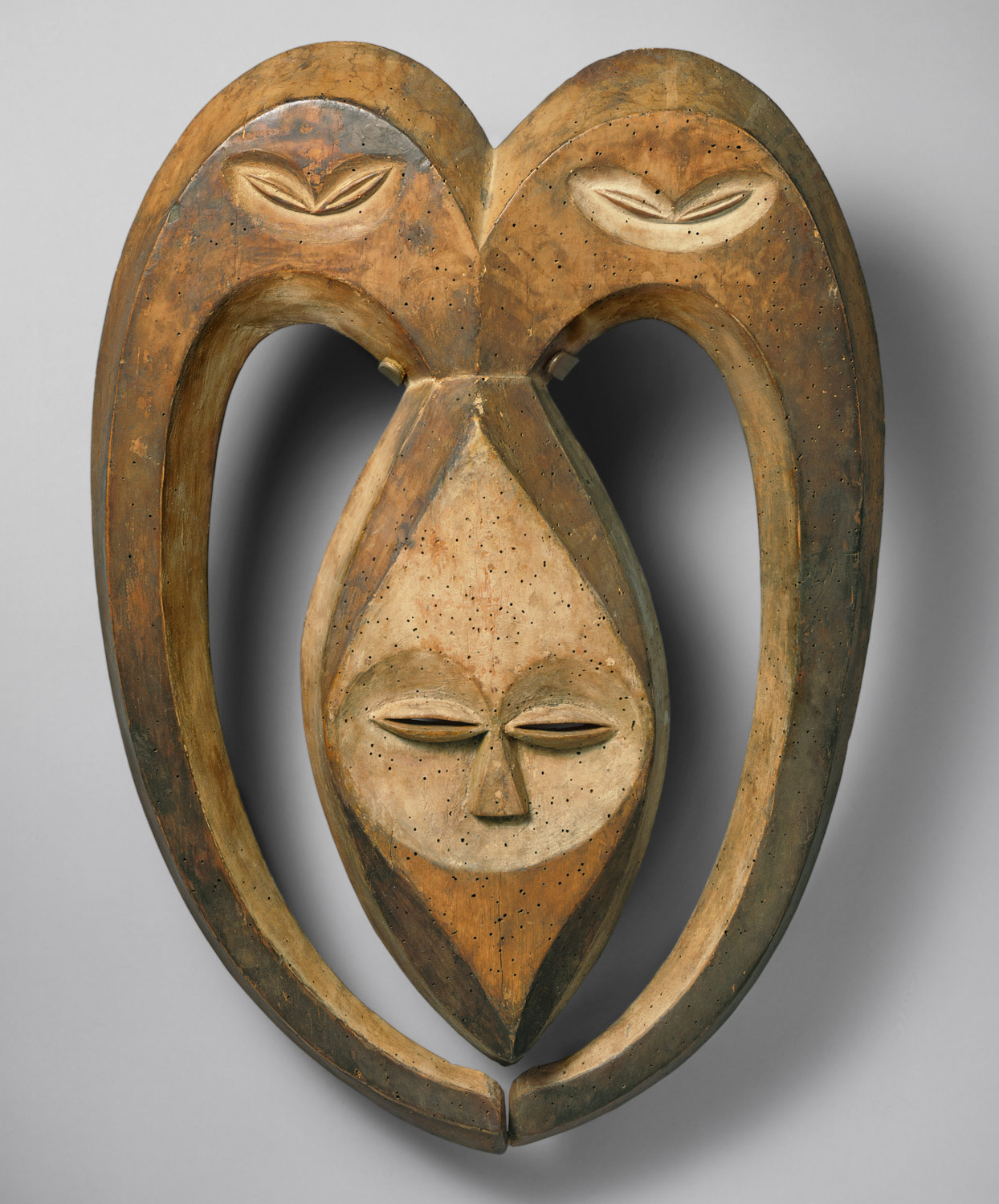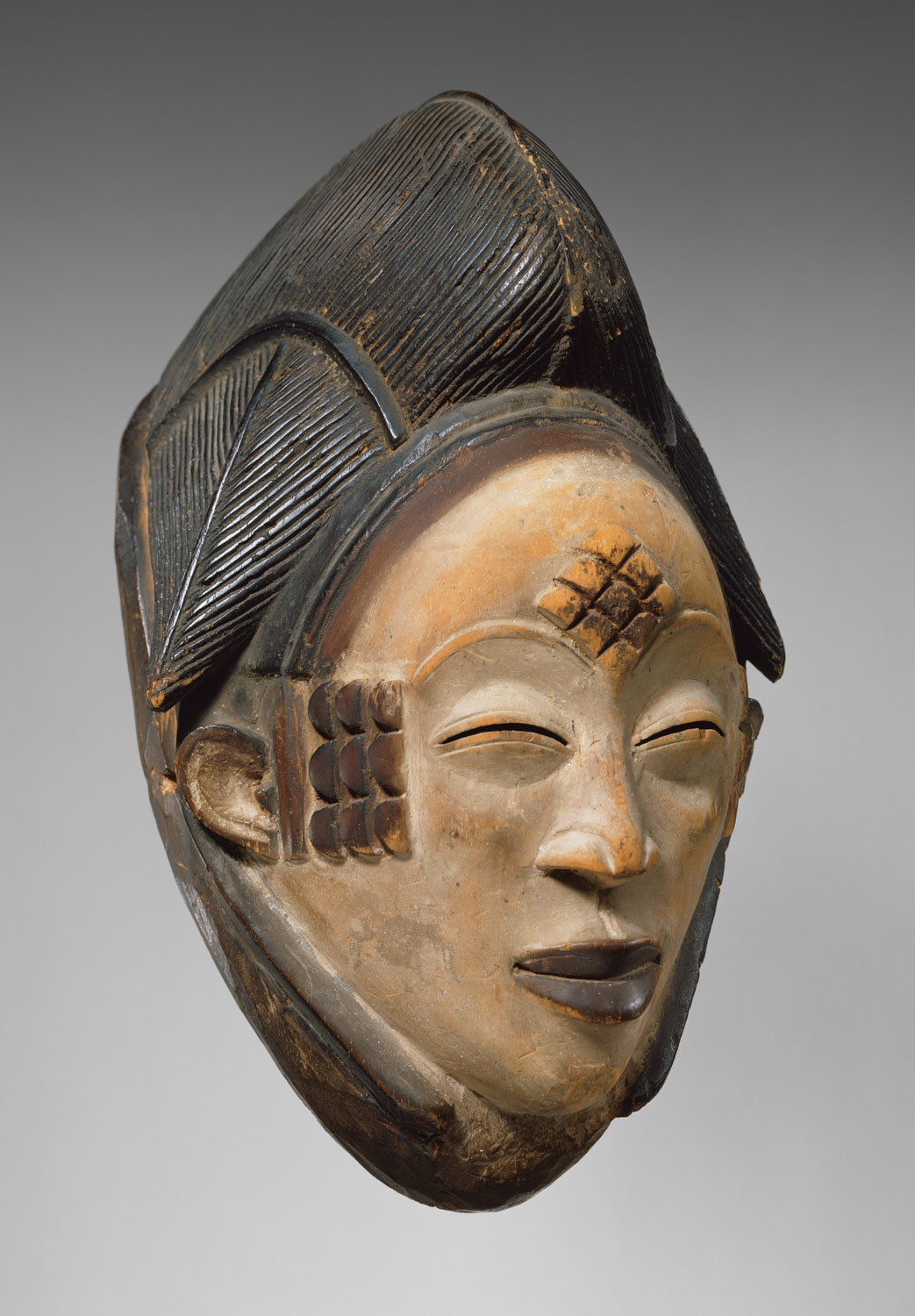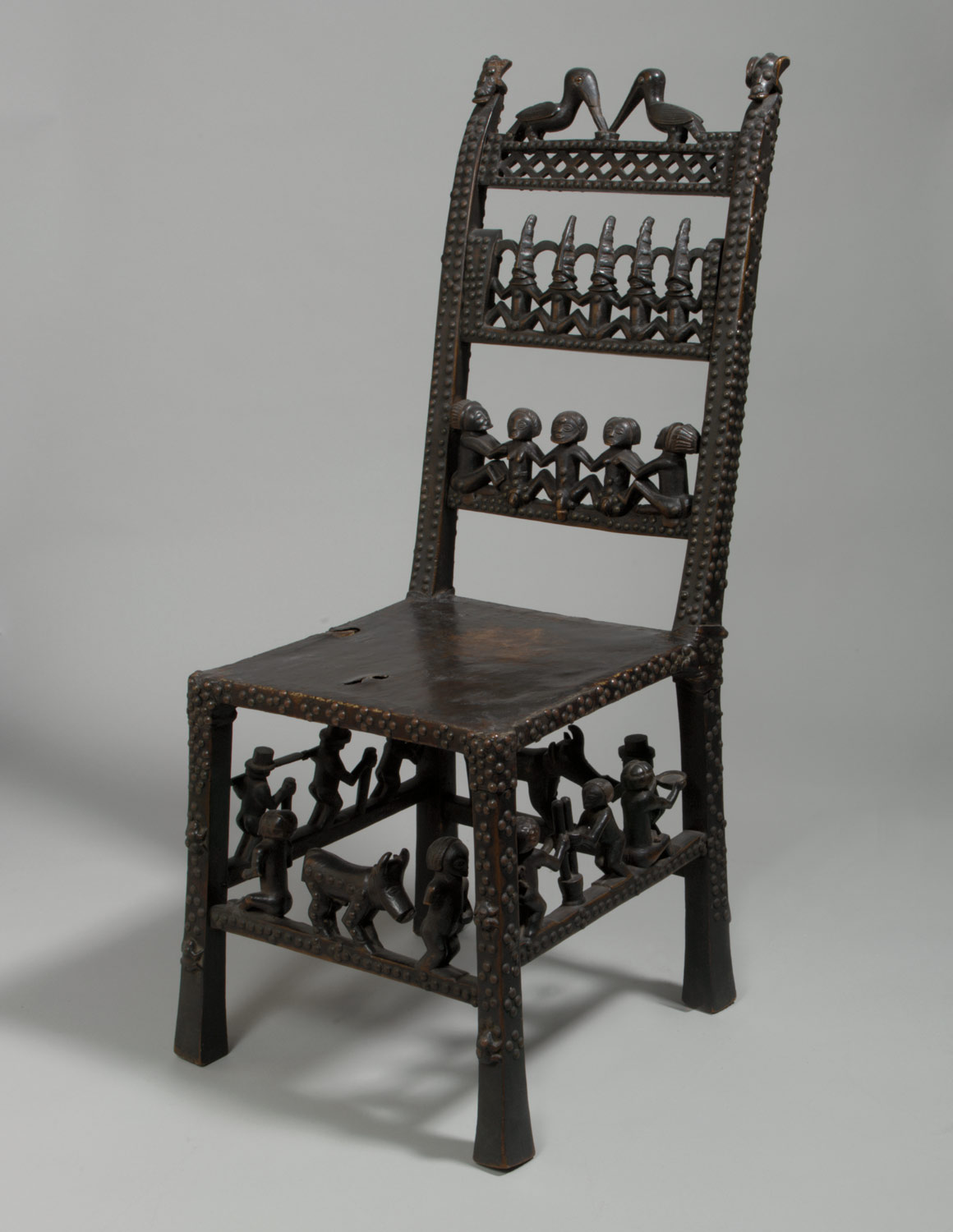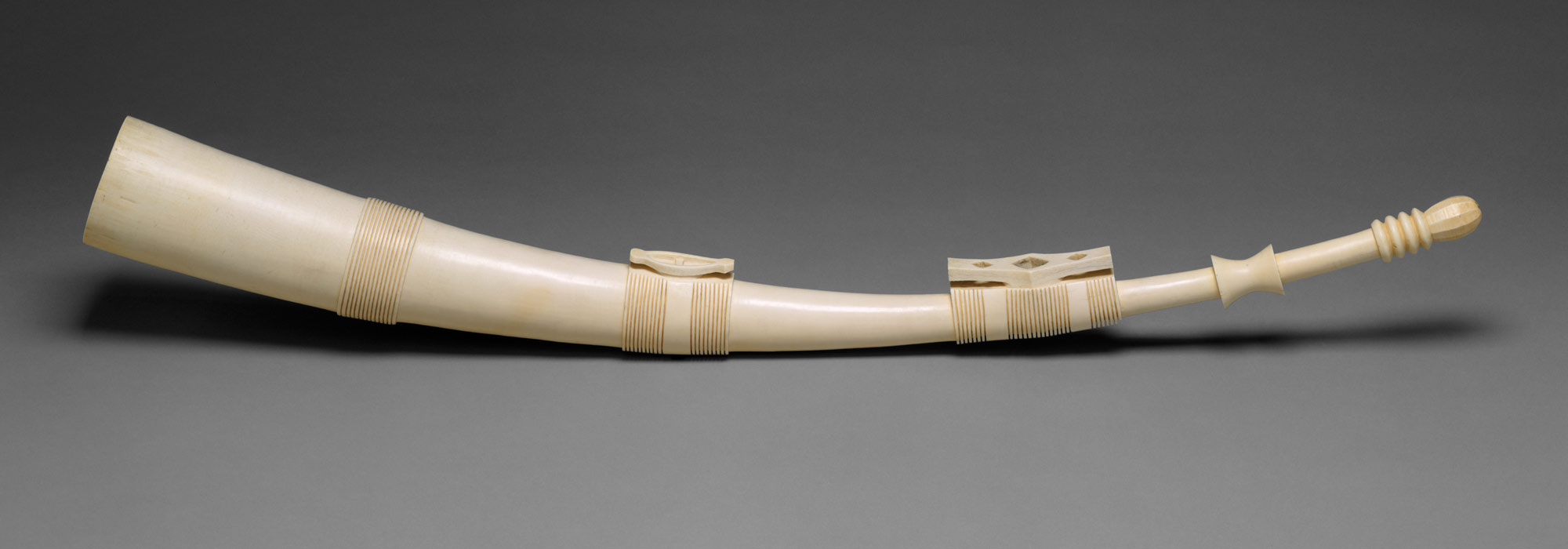With control of the Belgian Free State transferred from King Leopold to the Belgian republican government in 1908, all of Central Africa falls under the rule of European countries by the early twentieth century. As France, Belgium, Portugal, and (prior to 1918) Germany implement new political and economic structures to consolidate their control over Central Africa’s immense resources. The exploitative abuses of Belgian colonial rule were experienced by local populations as especially brutal and traumatic. During and after the colonial era, African artists and musicians such as Samuel Fosso, Grand Kallé, and Cheri Samba incorporate European techniques into their own creative processes, producing works that address the friction between traditional and colonial/postcolonial ways of life and speak to the aspirations of the emerging urban class. Europeans’ increased exposure to African societies and material culture, fostered by museum expeditions and the rapidly developing field of anthropology, inspires artists from Pablo Picasso to the British Vorticists to explore new subjects and methods of visual representation. The imposition of colonial boundaries and governmental systems gives rise to developing national consciousness among many Central Africans, inspiring movements to achieve political independence and reclaim indigenous African identity, such as Mobuto Sese Seko’s “authenticity” campaign and Tshibumba Kanda Matulu’s series of paintings on Congolese history.
Central Africa, 1900 A.D.–present
Timeline
1900 A.D.
1925 A.D.
1925 A.D.
1950 A.D.
1950 A.D.
1975 A.D.
1975 A.D.
2000 A.D.
Overview
Key Events
-
1900–1903
Europeans settle in North Africa and take control of key government positions and local industry. Local elites form alliances with colonists and their imposed government officials. The first motor cars appear in Cairo; new roads link North African cities. North Africa’s economies favor European interests. The French government opens the Musée d’Alger in Algiers to house French contemporary neo-Orientalist and Impressionist art. In Algeria, Tunisia, and Morocco, salons open exclusively for European artists.
-
1904–6
The French and Spanish governments divide Morocco into two separate protectorates, with France controlling the inland and Spain the coastal areas and Western Sahara. Imam Muhammad ‘Abduh, leader of the Islamic intellectual revival movement that calls for social, political, and religious reform in Egypt, dies in 1905. Egyptian liberals, inspired by the writings of Rifa’ah Rafi’ al-Tahtawi (1801–1873), reject theocracy and advocate the emancipation of women, modern education, and human rights. Many radical intellectuals are persecuted by the British.
-
1908–11
Italy colonizes Ottoman-controlled Libya. British and French occupiers support the education of civil servants and to a limited extent the arts, but fall short of supporting higher education that may result in an intellectual leadership. Prince Yusuf Kamal opens the School of Fine Arts in Cairo (later known as the Helwan University College of Fine Arts), offering free education by French and Italian instructors to qualified applicants under the patronage of Prince Kamal, who also establishes a scholarship fund for graduates to study in Europe. Mahmud Mukhtar (1891–1934) is the first graduate to study art at the École des Beaux-Arts in Paris. (In 1929, he has a solo exhibition at the Paris Salon, where he wins the gold medal for his sculptureThe Nile Bride.) In 1911, the first group exhibition of Egyptian artists opens in Cairo.
-
1912
Morocco officially becomes a French Protectorate under the Treaty of Fez. Spain retains influence in the southwest.
-
1912–14
The French confiscate Algerian land, leaving one-third of Algeria’s productive land under European ownership. The French control the government with representatives in Paris, and by now Algeria’s assimilation into France is almost complete. Annual exhibitions for European artists alternate between Casablanca, Algiers, and Tunis. Across North Africa, intellectuals debate the need for modernization through education and the revival of the Arabic language represented by the new free verse, short novels, and plays. Writers—among them, Egyptians Ahmad Zaki Abu Shadi and Taha Husayn, and Tunisian poet Abu al-Qasim al-Shabbi—and other liberal intellectuals influence artists through their break with past traditional literary forms, giving rise to new modes of personal expression and social criticism in tune with nature and their environment.
-
1915–19
In 1918, Sa’d Zaghlul (1857–1927) forms the Wafd party in Egypt, a secular-nationalist party working for independence. Egyptian women’s rights activist Hudá Sha’rawi (1879–1947) leads women’s struggle for emancipation. She later becomes the first female art patron, offering a sculpting award in honor of Mahmud Mukhtar. In 1918, the first Egyptian Society of Fine Arts is formed. In 1919, the struggle for independence peaks with the Egyptian Peasant Rebellion and the March of the Veils. Several Egyptian women writers contribute to literary salons and publish women’s magazines and journals. In the first part of the century, women’s contribution to literature and to the struggle for emancipation is more evident in Egypt than other North African countries. The emancipation of women, peasant uprisings against the old feudal system, and independence from foreign rule are common themes in Egyptian art and literature.
-
1920–24
The discovery of the tomb of Tutankhamun inspires Egyptian artists to form a link with their ancient past. Connecting present and past is made more popular in the modernist literature, plays, novels, and critical essays of Taha Husayn (1889–1973) and Tawfiq Hakim (1899–1987). Great Egyptian poet Ahmad Shawqi (1868–1932) is equally inspired by Egyptian nationalism, as evident in his popular poetry. With the support of the British, Fu’ad I (r. 1917–36) retains the title King of Egypt, followed by the official end to the British Protectorate. Elections result in a Wafd-controlled Parliament demanding a constitutional government, British withdrawal, and Egyptian control of the Suez Canal. The Tunisian movements against French occupation unite under the constitutional party Destour, calling for democratic reform; the French disband all national alliances. The French establish the first school of fine arts in Algeria (1920) and Tunisia (1923), offering limited enrollment to local artists. Yahia Turki (1901–1968), considered the father of modern Tunisian art, rejects Orientalist and academic styles and initiates a figurative trend that portrays a realistic view of Tunisian life. In Egypt, the newly established Society of the Friends of Art promotes art and art education for the public through lectures and exhibitions. The government issues grants for purchasing art. In 1923, the first Egyptian woman artist, Afifa Tawfiq, receives a grant to study art in London as part of the government’s new scholarship program to encourage art education.
-
1925–29
L’Étoile Nord-Africaine (North African Star) is founded in Algiers, the first secular-nationalist movement in Algeria, out of which the Parti du Peuple Algérien (Algerian People’s Party) and its militia form. In Egypt, the Committee of Fine Arts, later called the Higher Council for Patronage of Fine Arts, is created. The Egyptian Parliament passes legislation guaranteeing artists’ freedom of expression. In 1928, the Muslim Brotherhood forms in Egypt under Hasan al-Banna (1906–1949) calling for a conservative interpretation of Islam and an end to British occupation. The Brotherhood becomes the predecessor for a host of Islamic parties that gain widespread appeal in the last decades of the century. In 1929, the Egyptian Academy in Rome opens, offering the first space dedicated for Egyptian artists studying in Italy, many on government scholarships. All members of Egypt’s School of Fine Arts faculty are local artists.
-
1930–35
In Algeria, the National Museum of Fine Arts moves to a new building on the occasion of one hundred years of French colonialism. The “Villa Abdelatif” movement of French Impressionist painters settled in Algeria, including Maisonseul and Cuavy, attempt to disassociate their work from their status as French nationals and move toward a self-proclaimed universality in their depiction of Algerian culture. The Museum of Contemporary Art opens in Cairo (1931). In 1932, the Atelier Group opens the Alexandria Atelier; the founding members are European and Egyptian artists. The Atelier hosts exhibitions from Europe and for local artists; it also provides free classes, studios, and exhibition space. In 1934, the Neo-Destour party forms in Tunisia under the leadership of Habib Bourguiba (1903–2000) and will eventually lead the country to independence. In Morocco, nationwide opposition to the French campaign divides the population by giving limited autonomy to Berber Amazigh tribes. The French open an institute for the revival of Moroccan traditional art. The first film studios are established in Egypt.
-
1936–41
In 1936, large numbers of British troops leave Egypt, but are retained around the Suez Canal. British-supported King Farouq (1920–1965) remains in power; movements arise calling for free elections. In the 1930s, several art groups form in Egypt to foster public awareness of an authentically Egyptian contemporary art and more creative individualistic styles. They publish art journals in Arabic and French that cover art criticism, reviews, debates, and news of international art and introduce Surrealism, Cubism, and abstraction. The Egyptian government establishes the Atelier of Fine Arts for outstanding artists, providing stipends and sponsoring exhibitions. Egypt opens the first Egyptian art institute for women, later known as the College of Art Education, and the first museum dedicated to modern Egyptian artists.
-
1942–49
After 1940, the French in Tunisia align with the Vichy government. German troops land in Tunisia in 1942 and finally surrender to the Allied forces in 1943. In 1942, Allied forces land in Algeria and Morocco, oust Italy from Libya, and split control of the country between Britain and France. In 1943, the Istiqlal party forms, which will work toward Moroccan independence. The Allied victory ends World War II in 1945. Over 50,000 civilians are killed in Algeria’s continued resistance to French rule. Egypt is one of the founding members of the United Nations. The League of Arab States is founded by Egypt, Lebanon, Syria, Saudi Arabia, Yemen, and Transjordan, calling for Arab independence and opposing Zionist aspirations in Palestine. In 1948, Egypt along with other Arab armies suffer a major defeat against the newly created state of Israel. In 1945, two schools of art open in Casablanca and Tetuan (Spanish-controlled Morocco), providing the first modern art curriculum but restricted to an academic style. In 1947, the first Cairo International Exhibition of Art takes place.
-
1950–53
Libya becomes the Kingdom of Libya and the first independent North African nation under King Mohammad Idris al-Sanusi. In Algeria, the “Generation of 1952,” which includes artists and writers, dedicate their work to people’s struggle. French is the language many Algerian writers use to explore issues of identity and independence, among them Kateb Yacine (1929–1989). In 1952, the “Free Officer’s Revolt” overthrows the monarchy and establishes the Republic of Egypt headed by President Mohammed Naguib (1901–1984) and Prime Minister Gamal Abdel Nasser (1918–1970). In 1953, the first modern art exhibit opens at L’École d’Alger, dominated by the universalism movement and colonial ideology. The Egyptian Pavilion opens at the 1952 Venice Biennale.
-
1953–56
In Morocco, the struggle for independence gains momentum; the French conspire with tribal leaders to overthrow the sultan, which leads to his exile for two years. Morocco gains independence from the French in 1956. In 1957, the Alawite sultan Mohammed V (1909–1961) becomes king of Morocco. The new government introduces fellowships and grants for artists to study abroad. Tunisia is declared an independent, principally secular nation with a newly elected prime minister after decades of national uprisings and several treaties with the French. In Algeria, the National Liberation Front (FLN) leads the war of independence against the French. In Egypt, Gamal Abdel Nasser takes control of the government, disbands all parties, suspends the constitution, institutes land reform, and nationalizes industry. In 1956, Nasser nationalizes the Suez Canal, sparking an invasion by Britain, France, and Israel. The U.S. and USSR back Egypt’s claim and Egypt retains control of the canal. Cairo is the cultural capital of the region; its films, music, radio programs, newspapers, and their use of the now-dominant simplified and popular version of classical Arabic language are central to the cultural development in the region. Egyptian singer Umm Kulthum (1904?–1975) known as the Voice of Egypt, captivates the Arab world with her songs based on Arabic neoclassical and modern poetry. The Alexandria Museum of Art opens in 1954 to house an expanding collection of art by contemporary Alexandrian artists as well as the core collection donated by resident European artists. A year later, the new museum hosts the first Biennial for Mediterranean countries.
-
1957–59
The New College of Fine Arts opens in Cairo and Alexandria. A museum dedicated to modern artist Mahmud Said (1897–1964) is founded in Alexandria, and another to Muhammad Naghi (1888–1956) opens in Cairo. In 1958, Egypt and Syria take steps toward Arab unity by forming the short-lived United Arab Republic, which collapses by 1961. Nine years of construction begins on the Aswan Dam, which results in the flooding of large areas inhabited by Nubians; prior to evacuating the region, the government commissions artists to record their impressions of life on Nubian land. In 1959, six young Moroccan artists exhibit at the Paris Biennale des Jeunes Artistes, symbolic of the nation’s growing contemporary art movements. A literary movement sweeps the region with major publications in literature, social studies, historical interpretation, and art criticism. In Egypt, art critics’ reviews appear in daily newspapers and popular magazines, and artists interpret the country’s new reality through social realism and symbolism. Following the discovery of oil, Libya grants concessions to two U.S. companies.
-
1960–65
Algeria gains its independence after 132 years of French rule and seven years of armed resistance led by the National Liberation Front (FLN). In Morocco, Sultan Hassan II begins his reign in 1961 (he rules for thirty-eight years). Television is introduced in much of the region, but radio is still more popular. In 1965, Algeria’s Union Nationale des Arts Plastiques (National Union of Plastic Arts, UNAP) is formed, the first state-sponsored art group of the newly independent nation. Egypt hosts the first Alexandria Biennale for the Mediterranean countries.
-
1967–69
In June, the Six-Day Arab-Israeli War results in Egypt’s defeat and its loss of the Sinai Peninsula. It also deals a major blow to the Arab nationalist movement and hope of a unified Arab world. United Nations Resolution 242 calls for the withdrawal of Israel from all 1967 occupied territories. The region is increasingly dependent on superpowers and hopes for social reforms are dashed in the face of worsening economic conditions and disparities between the few oil-rich nations and countries with underdeveloped economies. Algeria’s Aouchem (Tatoo) Group calls for a revival of Berber-Algerian culture through art that utilizes true symbols and not abstraction. Moroccan and Tunisian artists break away from local influences and adopt abstraction, Expressionism, and Surrealism; others investigate the aesthetic elements of signs and symbols while adopting a variety of international trends. Colonel Muammar Qaddafi (born 1942) leads a coup of young military officers against the Libyan monarchy and establishes the Libyan Arab Republic, nationalizes the oil industry, and closes American and British military bases. Two prominent North African writers emerge in this period: Assia Djebar (born 1936), who explores in her writings and films the impact of the revolution on gender relations; and Moroccan cAbd al-Karim Ghallab (born 1919), whose novels—written in Arabic—examine the social structure of the urban struggle for independence. In 1969, the Fédération Panafricaine des Cinéastes (FEPACI) is established in Algiers “to use film as a tool for the liberation of the colonized countries and as a step toward the total unity of Africa.”
-
1970–73
The first Arab Art Biennale opens in Rabat, Morocco, part of a growing debate on the identity of contemporary Arab art. Anwar Sadat (1918–1981) becomes president of Egypt following the death of Nasser; Sadat initiates his infitah (“open door”) policy to liberalize the Egyptian economy and open the doors to foreign investment. Government support for the arts is limited to the opening of exhibition venues; however, artists lose the support they enjoyed in the first half of the century. Egypt and Syria launch a surprise attack on Israeli forces in occupied Sinai and Golan Heights to reclaim lost territories. The Egyptians incur major losses after an initial victory. The Arab oil-producing countries impose an oil embargo on nations that support Israel, which results in oil shortages and inflationary prices. The Polisario Front is born, calling for an independent nation in the Spanish-controlled Western Sahara. The Institute of Technology for Arts and Architecture opens in Tunis, continuing the work of the School of Fine Arts and training teachers.
-
1975–77
Thousands of Moroccans march into the Western Sahara led by King Hassan II to claim territory ceded by the Spanish government. The region remains under joint Moroccan-Mauritanian control against the wishes of the indigenous population, who are led in their fight against Moroccan control by the Polisario Front. President Sadat is the first Arab head of state to pay an official visit to Israel, making Egypt the first Arab country to open diplomatic relations with Israel. The visit and new relations with Israel are opposed by Egyptian intellectuals and professionals, and all other Arabs counties. Tourism is a growing contributor to the economies of Morocco, Tunisia, and Egypt.
-
1978
Egypt signs the Camp David Accords with Israel and regains Sinai by 1982. The new Algerian president Chadli Bendjedid (born 1929) initiates economic reforms that renounce his predecessor’s socialist programs. Palestinian-American scholar Edward Said (1935–2003) publishes Orientalism, a groundbreaking book that examines the Western colonial depiction of the Orient and its impact on twentieth-century colonial and postcolonial relations between the West and the Arab East. The shah of Iran is ousted by a national rebellion and takes refuge in Egypt. The first annual Asilah Festival opens in Morocco, which becomes a key venue for African and international contemporary artists, writers, and musicians. The festival focuses on a different theme each year; artists are invited to spend a month in Asilah’s art studios, and many leave their art to adorn the town’s squares and buildings.
-
1979–80
Three sites in Ethiopia receive world heritage status by UNESCO: the fortress city of Fasil Ghebbi (16th–17th century) in the Gondar region; Aksum, the capital of the Aksumite kingdom (ca. 300 B.C.–600 A.D.); and Tiya, a Prehistoric archaeological site in the Soddo region.
-
1980–85
Algerian Amazigh, or Berbers, demonstrate against the government ban on teaching their native language in public schools. The Palestinian Liberation Organization is forced out of Lebanon and takes refuge in Tunisia. Egyptian president Anwar Sadat is assassinated in 1981 by an Islamic extremist in retaliation for his clampdown on dissidents, the press, and freedom of speech and political assembly, his treaty with Israel, and his alignment with the West. Vice President Hosni Mubarak (born 1928) is elected president. In 1982, Egypt launches its first Cairo Biennial.
-
1981
The ruins of two great East African ports active between the thirteenth and sixteenth centuries, Kilwa Kisiwani and Songo Mnara in Tanzania, are designed world heritage sites by UNESCO.
-
1983
In Sudan, President Numayri imposes shari’a (Islamic law).
-
1985
The artist collective Rockson Studios is formed in Lusaka, Zambia. It is part of the Triangle Arts network of artists’ workshops and residencies in Africa.
-
1986–90
The U.S. attacks Libya, launching rockets into Tripoli and Benghazi and killing 101 people, in an attempt to assassinate Qaddafi after alleged Libyan involvement in the bombing of a Berlin discothèque frequented by U.S. military personnel. In Tunisia, Prime Minister Zayn al-‘Abidin Bin ‘Ali (born 1936) declares the ailing President Bourguiba mentally unfit to rule and stages a coup. High unemployment and lack of individual freedom lead to Algerian youth riots, at the cost of many lives. New policies grant freedom of speech and the creation of political parties; the Islamic Salvation Front wins a majority of seats in municipal elections, upsetting the power held by the FLN for over three decades. In 1988, Egyptian novelist Naguib Mahfouz (born 1912) wins the Nobel Prize for literature, and Francophone Moroccan writer Tahar Ben Jelloun (born 1944) receives the French Prix Goncourt for his novel The Sacred Night. In Morocco, the Museum of Contemporary Art opens in Tangier.
-
1991–97
Egypt acts as the third largest participant in the U.S.-led Gulf War against Iraq following the invasion of Kuwait. The United Nations imposes sanctions on Libya following its refusal to extradite two citizens charged with the 1988 Pan Am plane bombing over Scotland. A ceasefire, under United Nations brokerage, is imposed in the Western Sahara, but the referendum encouraged by the treaty is trapped in deadlock. The Algerian government cancels legislative elections on the eve of an expected victory by the Islamic Salvation Front (FIS), sparking a decade of civil war between the FLN-led government-military and the Armed Islamic Group (GIA), costing 200,000 lives, mostly civilians. In 1992, the military forms the Higher State Council (HCE) after forcing the president’s resignation and takes control; following the assassination of HCE head Mohamed Boudiaf that year, a military government holds power until elections are called in 1995. In Morocco, the Berber language Tamazight is officially sanctioned. Libyan artist Salah Zagruna (born 1970) exhibits at Expo Arte in Italy, one of the few Libyan artists to gain international exposure. His work is part of the growing contemporary art movement in Libya, which includes realist and other modern trends. Three Egyptian artists win the Leone d’Oro (Golden Lion) prize at the 1995 Venice Biennale: Medhat Shafik (born 1956), Akram al-Magdoub (born 1958), and Hamdi Attiah (born 1964).
-
1991
UNESCO declares the fortified city of Mozambique, on the island of the same name, a world heritage site.
-
1994
Genocide in Rwanda. Hutu militia backed by sectors of the military begin the systematic massacre of Tutsis, killing some 800,000 in three months.
-
1995
The Kouna Trust is founded at the National Museum of Kenya as a public outreach organization focused on promoting contemporary art.
-
1997
The Zanzibar Film Festival is established.
-
1997
The Paris-based world music label Buda Musique launches the Ethiopiques series, featuring compilations of traditional and popular music from Ethiopia and Eritrea. With twenty-five volumes as of December 2009, the series has been highly influential in popularizing singers and musicians from the Horn of Africa.
-
1998–2000
The Algerian civil war ends officially following a referendum-approved “Civil Concord” policy stipulating amnesty for all fighters and a treaty between FIS and AIS factions and the government; two radical Islamist groups oppose the agreement. In an unprecedented move, King Mohammed VI (born 1963) of Morocco, who comes to power in 1999, appoints a member of the opposition party as prime minister.
-
2000
In December, a peace accord is struck between Ethiopia and Eritrea, ending two years of conflict.
-
2000
UNESCO declares Stone Town of Zanzibar a world heritage site.
-
2001
Nigerian curator Okui Enwezor curates The Short Century: Independence and Liberation Movements in Africa, 1945–1994, for the Museum Villa Stuck in Munich. The exhibition travels to Berlin, New York, and Chicago.
-
2001
Sudanese Salah Hassan and Nigerian Olu Oguibe are the first African curators to participate in the Venice Biennale. Their exhibition is entitled Authentic / Ex-centric: Africa in and out of Africa.
-
2001
The Old Town of Lamu, in Kenya, is designated a world heritage site.
-
2001
The site of the tombs of Buganda kings at Kasubi in Kampala district, Uganda, is declared a UNESCO world heritage site.
-
2002
Rwanda and Democratic Republic of Congo sign a peace agreement stipulating that Rwanda will pull troops out of DRC and DRC will help disarm Rwandan Hutu mercenaries involved in the 1994 genocide of the Tutsi minority.
-
2003
Gebel Barkal and the sites of the Napatan region in Sudan are designated world heritage sites.
-
2003
Ethiopian-born American artist Julie Merethu has her solo debut with the exhibition Julie Mehretu: Drawing into Painting at the Walker Art Center in Minneapolis.
-
2004
Pro-government militias massacre thousands of villagers in Darfur, Sudan. The international community calls the systematic slaughter a genocide. The UN installs a peacekeeping force to disarm the militias. In May, the International Criminal Court in the Hague issues arrest warrants for the perpetrators of war crimes in Darfur.
-
2004
After protracted talks between Somali warlords and politicians, a tenuous central government is restored in Somali, with Abdullahi Yusuf as president.
-
2004
Kenyan ecologist Wangari Maathai wins the Nobel Peace Prize.
-
2004
The government of Malawi pledges to provide free antiviral drugs to people with AIDS.
-
2004–5
The exhibition Africa Remix: Contemporary Art of a Continent, under the curatorial direction of Simon Njami, travels to Düsseldorf, Paris, London, Tokyo, Stockholm, and Johannesburg.
-
2006
The fortified sacred town of Harar Jugol in Ethiopia and the rock-art sites in the Kondoa district in Tanzania are designated world heritage sites by UNESCO.
-
2007
A group of African artists is presented in the exhibition Think with the Senses, Feel with the Mind: Art in the Present Tense at the 52nd Venice Biennale. Works by about 100 artists and groups are shown at the Arsenale and the Italian Pavilion in the Giardini; Among the African artists represented in that section of the Biennale are paintings by Congolese Chéri Samba, photographs by Malian Malick Sidibé, comics by Ivoirian Faustin Titi and Cameroonian-born Eyoum Ngangué, and installations by Ghanaian-born El Anatsui. In addition to his monumental works shown in the Arsenale, Anatsui also transforms one of Venice’s most celebrated Gothic landmarks with a site-specific installation that redefined the facade of the Palazzo Fortuny.
-
2007–8
A political crisis erupts in Kenya following the presidential elections during which President Mwai Kibaki is declared the winner but accused by his opponent of electoral manipulation. Violent riots are quelled after a coalition agreement is signed in February 2008.
-
2008
The sacred Mijikenga Kaya forests in Kenya are declared world heritage sites. These forests contain the remains of numerous fortified villages built in the sixteenth century and abandoned in the 1940s.
-
2008
Simon Njami organizes the first African Art Fair in Johannesburg.
-
2009
A 4.4 million-year-old adult female skeleton, Ardipithecus ramidus, nicknamed “Ardi,” found in 1994 in Afar in the Great Rift Valley of northeastern Ethiopia, is identified as the oldest specimen on the hominid branch found to date.
Citation
“Central Africa, 1900 A.D.–present.” In Heilbrunn Timeline of Art History. New York: The Metropolitan Museum of Art, 2000–. http://www.metmuseum.org/toah/ht/?period=11®ion=afc (October 2004)
